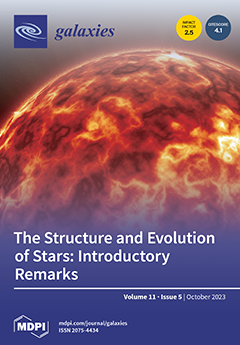We aim to combine asteroseismology, spectroscopy, and evolutionary models to establish a comprehensive picture of the evolution of Galactic blue supergiant stars (BSG). To start such an investigation, we selected three BSG candidates for our analysis: HD 42087 (PU Gem), HD 52089 (
[...] Read more.
We aim to combine asteroseismology, spectroscopy, and evolutionary models to establish a comprehensive picture of the evolution of Galactic blue supergiant stars (BSG). To start such an investigation, we selected three BSG candidates for our analysis: HD 42087 (PU Gem), HD 52089 (
CMa), and HD 58350 (
CMa). These stars show pulsations and were suspected to be in an evolutionary stage either preceding or succeding the red supergiant (RSG) stage. For our analysis, we utilized the 2-min cadence TESS data to study the photometric variability, and we obtained new spectroscopic observations at the CASLEO observatory. We used non-LTE radiative transfer models calculated with CMFGEN to derive their stellar and wind parameters. For the fitting procedure, we included CMFGEN models in the iterative spectral analysis pipeline
XTgrid to determine their CNO abundances. The spectral modeling was limited to changing only the effective temperature, surface gravity, CNO abundances, and mass-loss rates. Finally, we compared the derived metal abundances with prediction from Geneva stellar evolution models. The frequency spectra of all three stars show stochastic oscillations and indications of one nonradial strange mode,
0.09321
in HD 42087 and a rotational splitting centred in
0.36366
in HD 52089. We conclude that the rather short sectoral observing windows of TESS prevent establishing a reliable mode identification of low frequencies connected to mass-loss variabilities. The spectral analysis confirmed gradual changes in the mass-loss rates, and the derived CNO abundances comply with the values reported in the literature. We were able to achieve a quantitative match with stellar evolution models for the stellar masses and luminosities. However, the spectroscopic surface abundances turned out to be inconsistent with the theoretical predictions. The stars show N enrichment, typical for CNO cycle processed material, but the abundance ratios did not reflect the associated levels of C and O depletion. We found HD 42087 to be the most consistent with a pre-RSG evolutionary stage, HD 58350 is most likely in a post-RSG evolution and HD 52089 shows stellar parameters compatible with a star at the TAMS.
Full article





